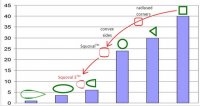Hexacrafter
Manufacturer
HexaCrafter Frame Strength- The Explanation
Over the last couple years, we have been asked many questions about our frame design as it is unique. The HexaCrafter airframes were designed using computer assisted structural design modeling to obtain the strongest possible arm, arm to frame & arm to motor mount systems.
The arms are rectangular. This is by design. For those familiar with structural shapes, the rectangular tube and I-Beam are the "go to" shapes for structural engineers. These shapes produce the minimum deflection and maximum strength by cross section of materials. The rectangular tube further was chosen as it allows for "simple" component connections with maximum strength. Take the time to "look up" the next time you are at Home Depot, Lowes, or any other building with exposed structure. The main beams spanning the columns are rectangular steel tubes most of the time. Have you ever seen a "Round" steel beam spanning the columns?
Many have commented about a "round" arm being better for aerodynamics. We respond by saying that on a Multicopter, Nothing is aerodynamic. Add a large 3-axis gimbal hanging below and the concept of aerodynamics is completely moot. The custom fabricated rectangular arm tubes we use have radiused corners. Eliminating the "sharp" corners assists with aerodynamics, but we have not been able to see any significant thrust loss or resistance in our rectangular tube design as compared with other Multicopter arm designs. Square arms have been used for multicopters by many DIY & competitor frames from the beginning of multicopters for the strength & connection advantages.
We have designed continuous internal bolted connection construction for all arm to frame & arm to motor mount connections. This connection is the strongest connection we were able to model & test. Additionally, three bolts are used at each connection to provide "triangulation" for maximum strength and shearing forces.
Over the last two years our frames have survived devastating aircraft crashes with minimal or no damage. This was also a main goal in our design. As of this date, no client has broken an arm, main frame or arm connection in major crashes that would most likely been devastating to many competitor airframes.
I know that this posting will most likely "stir" the pot of controversy over frame designs, arm shapes, aerodynamics, but our frames have proven themselves over and over for frame strength, minimal deflection, durability & flexibility of design for 2 years. We are very proud of our design as it has accomplished it's goal....Extremely durable, lightweight, easily serviceable, and priced below our big name competitors.
Please view the video of frame strength:
I hope that some of our clients who have experienced our frame strength first hand will post their experiences and share them with the Forum. We have received many amazing reports of accident survival from our clients.
Thanks again to the Forum for allowing us share our design & opinions.
Andrew Raines
Over the last couple years, we have been asked many questions about our frame design as it is unique. The HexaCrafter airframes were designed using computer assisted structural design modeling to obtain the strongest possible arm, arm to frame & arm to motor mount systems.
The arms are rectangular. This is by design. For those familiar with structural shapes, the rectangular tube and I-Beam are the "go to" shapes for structural engineers. These shapes produce the minimum deflection and maximum strength by cross section of materials. The rectangular tube further was chosen as it allows for "simple" component connections with maximum strength. Take the time to "look up" the next time you are at Home Depot, Lowes, or any other building with exposed structure. The main beams spanning the columns are rectangular steel tubes most of the time. Have you ever seen a "Round" steel beam spanning the columns?
Many have commented about a "round" arm being better for aerodynamics. We respond by saying that on a Multicopter, Nothing is aerodynamic. Add a large 3-axis gimbal hanging below and the concept of aerodynamics is completely moot. The custom fabricated rectangular arm tubes we use have radiused corners. Eliminating the "sharp" corners assists with aerodynamics, but we have not been able to see any significant thrust loss or resistance in our rectangular tube design as compared with other Multicopter arm designs. Square arms have been used for multicopters by many DIY & competitor frames from the beginning of multicopters for the strength & connection advantages.
We have designed continuous internal bolted connection construction for all arm to frame & arm to motor mount connections. This connection is the strongest connection we were able to model & test. Additionally, three bolts are used at each connection to provide "triangulation" for maximum strength and shearing forces.
Over the last two years our frames have survived devastating aircraft crashes with minimal or no damage. This was also a main goal in our design. As of this date, no client has broken an arm, main frame or arm connection in major crashes that would most likely been devastating to many competitor airframes.
I know that this posting will most likely "stir" the pot of controversy over frame designs, arm shapes, aerodynamics, but our frames have proven themselves over and over for frame strength, minimal deflection, durability & flexibility of design for 2 years. We are very proud of our design as it has accomplished it's goal....Extremely durable, lightweight, easily serviceable, and priced below our big name competitors.
Please view the video of frame strength:
Thanks again to the Forum for allowing us share our design & opinions.
Andrew Raines
Last edited by a moderator:

